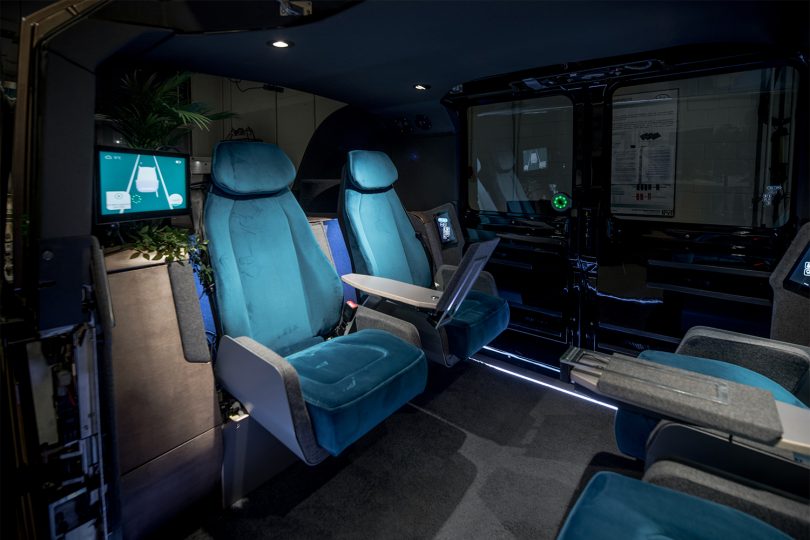Autonomous Shuttle RAION Presented Minister Olaf Lies visited the Automotive Research Centre Niedersachsen
A highlight of the day was the presentation of the autonomous shuttle RAION. The prototypical Level 4 vehicle concept based on an intelligent and electrified driving platform with a customised body is an in-house development by the team around Professor Dr.-Ing. Roman Henze and the engineer Torben Hegerhorst, who is largely responsible. On 18 July, Lower Saxony’s Minister of Economics, Olaf Lies, was able to get an idea of the new research vehicle of the Institute of Automotive Engineering at Technische Universität Braunschweig. During a tour of the Automotive Research Centre Niedersachsen (NFF), the minister also gained an insight into current research into vehicle concepts, intelligent vehicles, emission-free driving and the associated social transformation processes.
New, clean drive systems, intelligent and connected vehicles, autonomous driving in application and resulting questions in the areas of law, work, production and sales – the challenges in the transformation of mobility are enormous. During his summer visit to Braunschweig, Lower Saxony’s Minister of Economic Affairs was able to see for himself how the Automotive Research Centre (NFF) is mastering all of this.
Minister Olaf Lies: “We are currently working intensively on the Mobility Concept 2040. In order for the mobility turnaround to succeed, we need to think about all the building blocks together – efficient and reliable local public transport is a very decisive pillar in this. New concepts are needed, especially in rural areas. The challenges for public transport in rural areas will not be solvable without autonomous driving. I see great potential here – for example, autonomous public transport shuttles can be combined with smart, flexible on-demand services. Today, it was once again impressively demonstrated that the automotive heart of the future beats in Lower Saxony. For this, we as the state government support the exchange between industry and science. The innovations needed for autonomous driving are already interesting for current vehicle generations and are already finding their way onto the market. We want to put them on the road in Lower Saxony.”
“The Automotive Research Centre Niedersachsen shows once again how structured, networked and application-oriented research into the mobility of the future is being carried out here in Braunschweig. Another milestone in the field of autonomous driving is the new RAION research vehicle, which we were able to present today. With a view to the mobility of the future, we are thinking not only about the necessary technologies but also about all areas – including, for example, emission-free driving, the transformation processes in the world of work and in business models as well as mobility law,” says Angela Ittel, President of TU Braunschweig.
RAION – Japanese for lion – is the demonstrator of an autonomous public transport shuttle (Level 4) and serves to research and test future autonomous driving systems (AD), driving functions and vehicle concepts in real road traffic. A special feature compared to many previous demonstrations is the design of the AD system for high – traffic-adapted – speeds of a real driverless vehicle of up to 50 km/h. The necessary functional safety is realised in regular operation by triple redundant systems (two of them in the vehicle and one protection via the infrastructure). Prof. Dr. Ing. Roman Henze, head of the NFF research field “Intelligent Vehicle and Connected Driving”: “With the rollout of our RAION, we are taking the next step towards pilot operation of an autonomous transport system on Hermann-Blenk-Straße. In the coming months, we will go through all the steps of the approval and licensing process – with the goal of putting a real driverless passenger shuttle into operation from mid-2024 in flowing traffic and at a high frequency or according to individual customer needs.”
In cooperation with TÜV-Nord, approval for public road traffic has already been obtained, which is an important step towards achieving this goal. “The vehicle is equipped with high-precision 360° sensor technology based on laser scanners and the necessary localisation units and high-performance computers,” explains project manager Torben Hegerhorst and continues: “This means that the vehicle will be used to shed light on technical issues of the AD system as well as to carry out user-centred investigations – important steps towards being able to design the sustainable mobility of tomorrow.” The vehicle design, developed together with the Braunschweig-based company Formherr, invites the public to participate in this development process through its open design and at the same time underlines the technological orientation of the project.
NFF Board Spokesman Prof.-Dr.-Ing. Thomas Vietor: “In addition to the numerous technical challenges that still lie ahead of us, we must above all also take into account the perspective of the users, because technological progress can only be successfully implemented through broad acceptance. With the new test vehicle, a Level 4-capable car will pick us up right on our doorstep in the future and enable us to experience fully automated driving here at Braunschweig Research Airport.”
About the NFF
The NFF focuses on future topics in vehicle and transport technology research. It was founded in 2007 with the support of the government of Lower Saxony and Volkswagen AG in order to establish the Braunschweig research region as a top location for vehicle technology with international standing. The central vision is sustainable mobility, which is implemented in five research fields:
- Automated and connected driving
- Emission-free vehicle and drive systems
- Digitalisation and artificial intelligence
- Flexible vehicle concepts and vehicle production
- Transformation of mobility, work and business models
The NFF currently has 48 members, who are not only made up of institutes from the universities of Braunschweig, Hannover and Clausthal, but also from other research institutions in the region (including Fraunhofer, Ostfalia, Wolfsburg AG).

